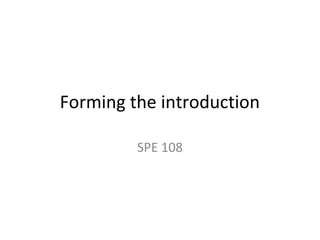
SPE 108: Generating the Central Idea and Determining the Specific Purpose
- 1. Forming the introduction SPE 108
- 2. Determining the general purpose & specific purpose • What is the broad goal of your speech? General Purpose Example: inform or persuade • What do you precisely hope to accomplish? Specific Purpose Example: To inform my audience about the benefits of music theory for people with cognitive delays
- 3. Formulating a specific purpose statement • Write the purpose statement out as a full sentence Forces you to fully articulate your purpose • Express your purpose as a statement, not a question A question doesn’t make you choose a direction for where your speech will go • Avoid figurative language in your purpose statement Forces you to be specific, and avoid sweeping statements
- 4. Formulating a specific purpose statement • Limit your purpose to one distinct idea Forces you to focus your direction • Make sure your specific purpose is not too vague or general If it is, it’s NOT a specific purpose statement
- 5. Questions to ask about your specific purpose 1. Does my purpose meet the assignment? 2. Can I accomplish my purpose in the time allotted? 3. Is the purpose relevant to my audience? 4. Is the purpose too trivial for my audience? 5. Is the purpose too technical for my audience?
- 7. The Central Idea • Central idea: a one sentence statement that sums up the major ideas of a speech • A concise statement about what you expect to say • Essentially the same as a thesis statement in a written paper • Your residual message – what you expect the audience to remember after you’re finished speaking • The central idea usually emerges after most of your research is complete, and you have already decided on the three main points of your speech.
- 8. Guidelines for the central idea The central idea: 1. Should be expressed in a full sentence 2. Should not be in the form of a question 3. Should avoid figurative language 4. Should not be vague or overly general
